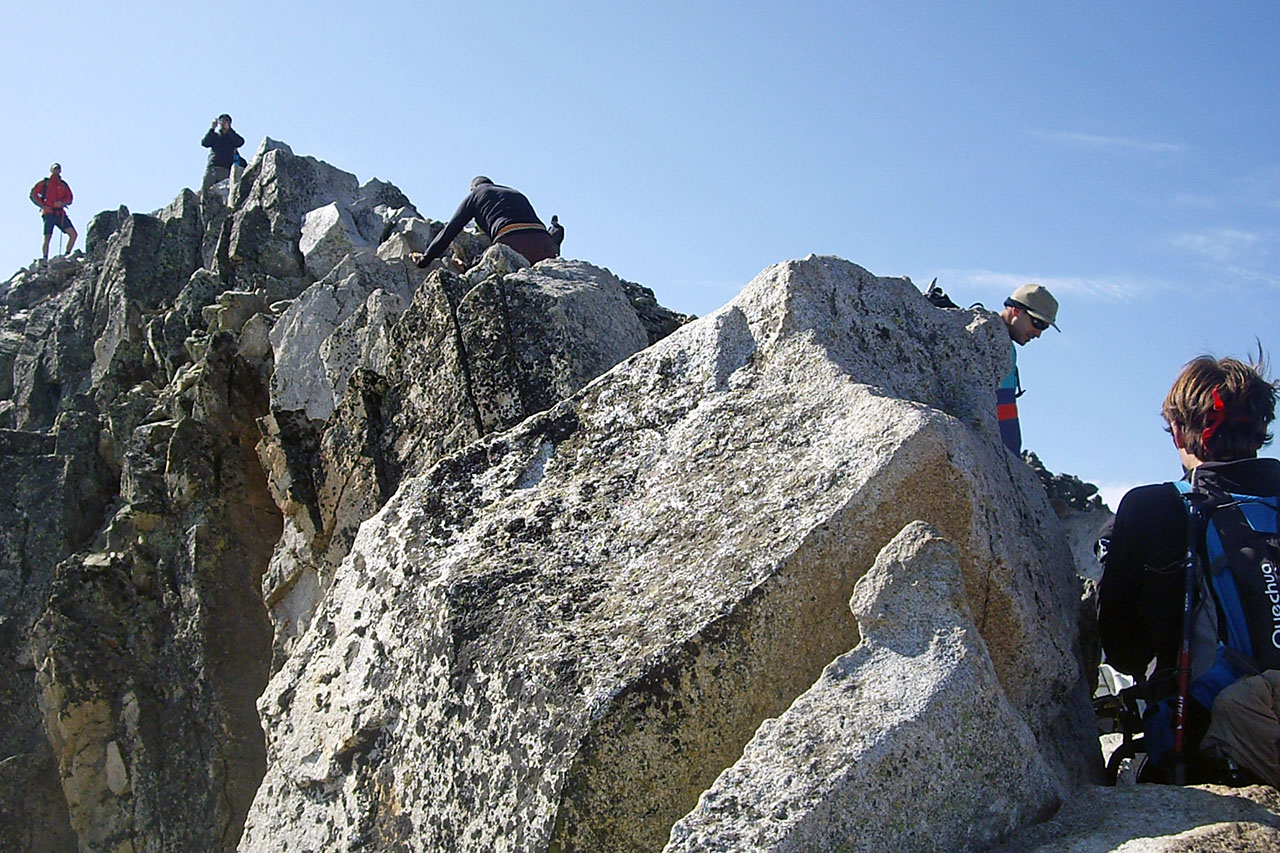Muhammad Pass or Muhammad Bridge?

Mohammed Pass, Mohammed Bridge... is it one, is it the other, is it the same? Well, the correct answer is Mohammed Bridge and no, it doesn't matter what you call it, don't make that mistake.
The Mohammed Bridge is a narrow horizontal ridge of about 40 metres in distance separating the top of the Anetor from the summit itself. It is a narrow stretch of ridge on granite blocks, which, although not difficult, is a bit of a challenge for people unaccustomed to this type of passages due to the drop on both sides. A frequent occurrence, on the other hand, on the crowded roof of the Pyrenees, which has recently left us with viral images of long queues to cross it (nothing new, as in 1857, Lézat and five other companions led 22 tourists to the summit).
The fact is that from the middle of the 20th century, probably due to the great affluence of this place and because in the mountains we usually use the word "paso" to designate an isolated climbing difficulty, "Puente" began to be replaced by "Paso", and used interchangeably. The repeated repetition of the error made it become part of our vocabulary and today there are those who knowingly do not give up and even justify it.
But let's go back to the origin. To find out why the correct designation is Mohammed Bridge and not Mohammed PassWe have to go back to the year 1842, to the first ascent of Aneto by a Russian soldier, Platon de Tchihatcheff, his local guide Jean-Pierre Sanyou (Pierre Sanio) and the porters Bernard Arrazu "Ursule" and Pierre Redonnet "Nate", who were joined almost by chance by a Norman botanist called Albert de Franqueville and his guide Jean Sors "Aragot", the latter being a fighter of Spanish origin. A first ascent that fortunately left us two written testimonies for history and where, precisely, in the one published by the botanist Albert de Franqueville, we find the reason for the denomination of Mohammed Bridge.
To the original text published by Franqueville three years after the first ascent and of which there is a booklet in French (First ascent of Néthou) which contains it, we have not had access to it, however, from very early on various authors collected extensive extracts and today we can find it in numerous publications translated into Spanish, such as in The Conquest of the Pyrenees by Marcos Feliú (Sua edizioak), in Pyrenean summits by Claude Dendaletche (Sua edizioak) or in the monographic issue of the Aneto: The Monarch of the Pyrenees by Alberto Martinez Embid (Ediciones Desnivel).
From the latter text we reproduce an excerpt from Franqueville's original:
"The moment we arrived there, we stopped in amazement at the appearance of the pass that remained to be crossed. We were separated from the peak of Aneto (Nethou reproduce Feliú) by an extremely sharp ridge; to the right, an abyss opened up beneath our feet, at the bottom of which stretched the Coronas glacier [...]. To make matters worse, the cusp of this ridge was obstructed by fragments of granite broken off by the frost or dislocated by lightning, very dangerous because of their lack of stability. This Mohammed Bridge It was, therefore, the only way open to us to reach the goal which we were crowning after so long a time. We hesitated for a moment, I confess, before undertaking this narrow pass; but at the sight of our hunters, who were advancing as surely as if they were on a path, we were soon determined to imitate them. [...] We advanced little by little, passing our arms over the ridge and supporting ourselves with our shod staff. Our feet were placed on the roughness of the rocks. Suspended above a frightful precipice, we only had to lower our eyes to see below us the waters on the Coronas side; whereas, if we had let our stick slip away, it would have been lost in the crevasses of the Aneto glacier. Thus, on horseback, so to speak, on the mountain, it took us only a few seconds to cross this dangerous pass. At last, we set foot on the peak, hitherto untouched by man's footprint".
As you can see, Albert de Franqueville, an enlightened man in an era marked by romantic thought (Romanticism), wanted to give us this literary ornament in which he compared this narrow ridge to the Sirat, a bridge over hell, thinner than a hair and sharper than a sabre, which all people must cross on the Day of Resurrection, according to Islam.
Other versions:
Within the rumourology and myths and legends of Aneto, some scholars point to other versions. The best known says that on conquering Aneto, the guides shouted to the Count of Franqueville: "Come on, it's easy, commend your soul to God", to which he replied: "more likely to the devil or to Mohammed! In this case, it would leave a loophole for the name Pass of Mohammed, although, as we have said, these alternative versions should be considered more as legends than anything else.
Conclusion:
In conclusion, now that we know the history and the reasons behind the Mohammed Bridge and no, Mohammed PassWe have a duty as mountaineers to call it by its name and to warn those who make this mistake. It is about respecting history. It is about being part of the solution.
Don't miss any adventure in the Pyrenees!
